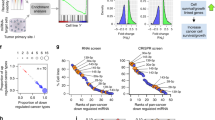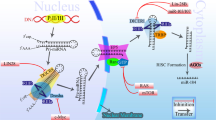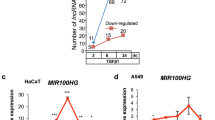Abstract
A global decrease in microRNA (miRNA) levels is often observed in human cancers1,2, indicating that small RNAs may have an intrinsic function in tumour suppression. To identify miRNA components of tumour suppressor pathways, we compared miRNA expression profiles of wild-type and p53-deficient cells. Here we describe a family of miRNAs, miR-34a–c, whose expression reflected p53 status. Genes encoding miRNAs in the miR-34 family are direct transcriptional targets of p53, whose induction by DNA damage and oncogenic stress depends on p53 both in vitro and in vivo. Ectopic expression of miR-34 induces cell cycle arrest in both primary and tumour-derived cell lines, which is consistent with the observed ability of miR-34 to downregulate a programme of genes promoting cell cycle progression. The p53 network suppresses tumour formation through the coordinated activation of multiple transcriptional targets, and miR-34 may act in concert with other effectors to inhibit inappropriate cell proliferation.
This is a preview of subscription content, access via your institution
Access options
Subscribe to this journal
Receive 51 print issues and online access
$199.00 per year
only $3.90 per issue
Buy this article
- Purchase on SpringerLink
- Instant access to full article PDF
Prices may be subject to local taxes which are calculated during checkout




Similar content being viewed by others
References
Lu, J. et al. MicroRNA expression profiles classify human cancers. Nature 435, 834–838 (2005)
Thomson, J. M. et al. Extensive post-transcriptional regulation of microRNAs and its implications for cancer. Genes Dev. 20, 2202–2207 (2006)
Levine, A. J., Hu, W. & Feng, Z. The p53 pathway: what questions remain to be explored? Cell Death Differ. 13, 1027–1036 (2006)
Ko, L. J. & Prives, C. p53: puzzle and paradigm. Genes Dev. 10, 1054–1072 (1996)
Hollstein, M., Sidransky, D., Vogelstein, B. & Harris, C. C. p53 mutations in human cancers. Science 253, 49–53 (1991)
Dickins, R. A. et al. Probing tumor phenotypes using stable and regulated synthetic microRNA precursors. Nature Genet. 37, 1289–1295 (2005)
Spurgers, K. B. et al. Identification of cell cycle regulatory genes as principal targets of p53-mediated transcriptional repression. J. Biol. Chem. 281, 25134–25142 (2006)
Bartel, D. P. MicroRNAs: genomics, biogenesis, mechanism, and function. Cell 116, 281–297 (2004)
Chen, C. et al. Real-time quantification of microRNAs by stem-loop RT-PCR. Nucleic Acids Res. 33, e179 (2005)
Fei, P. & El-Deiry, W. S. P53 and radiation responses. Oncogene 22, 5774–5783 (2003)
Giaccia, A. J. & Kastan, M. B. The complexity of p53 modulation: emerging patterns from divergent signals. Genes Dev. 12, 2973–2983 (1998)
Sherr, C. J. & Weber, J. D. The ARF/p53 pathway. Curr. Opin. Genet. Dev. 10, 94–99 (2000)
Xue, W. et al. Senescence and tumour clearance is triggered by p53 restoration in murine liver carcinomas. Nature 445, 656–660 (2007)
Wei, C. L. et al. A global map of p53 transcription-factor binding sites in the human genome. Cell 124, 207–219 (2006)
Lim, L. P. et al. Microarray analysis shows that some microRNAs downregulate large numbers of target mRNAs. Nature 433, 769–773 (2005)
Lewis, B. P., Burge, C. B. & Bartel, D. P. Conserved seed pairing, often flanked by adenosines, indicates that thousands of human genes are microRNA targets. Cell 120, 15–20 (2005)
Miyashita, T. & Reed, J. C. Tumor suppressor p53 is a direct transcriptional activator of the human bax gene. Cell 80, 293–299 (1995)
Villunger, A. et al. p53- and drug-induced apoptotic responses mediated by BH3-only proteins puma and noxa. Science 302, 1036–1038 (2003)
Brugarolas, J. et al. Radiation-induced cell cycle arrest compromised by p21 deficiency. Nature 377, 552–557 (1995)
Deng, C., Zhang, P., Harper, J. W., Elledge, S. J. & Leder, P. Mice lacking p21CIP1/WAF1 undergo normal development, but are defective in G1 checkpoint control. Cell 82, 675–684 (1995)
Lohr, K., Moritz, C., Contente, A. & Dobbelstein, M. p21/CDKN1A mediates negative regulation of transcription by p53. J. Biol. Chem. 278, 32507–32516 (2003)
Welch, C., Chen, Y. & Stallings, R. L. MicroRNA-34a functions as a potential tumor suppressor by inducing apoptosis in neuroblastoma cells. Oncogene advance online publication, doi:10.1038/sj.onc.1210293 (12 February 2007)
Calin, G. A. et al. MicroRNA profiling reveals distinct signatures in B cell chronic lymphocytic leukemias. Proc. Natl Acad. Sci. USA 101, 11755–11760 (2004)
Bagchi, A. et al. CHD5 is a tumor suppressor at human 1p36. Cell 128, 459–475 (2007)
Sutcliffe, J. E. & Brehm, A. Of flies and men; p53, a tumour suppressor. FEBS Lett. 567, 86–91 (2004)
Ruby, J. G. et al. Large-scale sequencing reveals 21U-RNAs and additional microRNAs and endogenous siRNAs in C. elegans. Cell 127, 1193–1207 (2006)
Raymond, C. K., Roberts, B. S., Garrett-Engele, P., Lim, L. P. & Johnson, J. M. Simple, quantitative primer-extension PCR assay for direct monitoring of microRNAs and short-interfering RNAs. RNA 11, 1737–1744 (2005)
Jackson, A. L. et al. Expression profiling reveals off-target gene regulation by RNAi. Nature Biotechnol. 21, 635–637 (2003)
Brummelkamp, T. R., Bernards, R. & Agami, R. A system for stable expression of short interfering RNAs in mammalian cells. Science 296, 550–553 (2002)
Acknowledgements
We thank members of the Hannon and Lowe laboratories and the Rosetta Biology group for helpful input; M. Zhang and J. Burchard for bioinformatic analysis; J. Guo, C. Raymond and K. Niemeyer for miRNA quantification; J. Schelter and M. Kibukawa for cell cycle analyses and gene expression profiling; R. Diaz, M. Mehaffey, F. Huynh and the Rosetta Gene Expression Laboratory for technical assistance; and R. Dickins, J. Kurland, M. McCurrach, K. Diggins, A. Chicas, B. Stillman and B. Vogelstein for providing reagents and protocols. L.H. is a Fellow of the Helen Hay Whitney Foundation and is supported by a K99 grant from the NCI. S.W.L. and G.J.H. are supported by a program project grant from the NCI and are investigators of the Howard Hughes Medical Institute. This work was also supported in part by a gift from K. W. Davis.
Author information
Authors and Affiliations
Corresponding authors
Ethics declarations
Competing interests
Reprints and permissions information is available at www.nature.com/reprints. The authors declare no competing financial interests.
Supplementary information
Supplementary Information
This file contains Supplementary Figures S1-S8, Supplementary Tables S1-S2, Supplementary Methods and additional references. (PDF 3172 kb)
Rights and permissions
About this article
Cite this article
He, L., He, X., Lim, L. et al. A microRNA component of the p53 tumour suppressor network. Nature 447, 1130–1134 (2007). https://doi.org/10.1038/nature05939
Received:
Accepted:
Published:
Issue Date:
DOI: https://doi.org/10.1038/nature05939
This article is cited by
-
Multifunctional elastin-like polypeptide nanocarriers for efficient miRNA delivery in cancer therapy
Journal of Nanobiotechnology (2024)
-
Association of TP53 rs1042522 G > C, MDM2 rs2279744 T > G, and miR-34b/c rs4938723 T > C polymorphisms with aneuploidy pregnancy susceptibility
BMC Pregnancy and Childbirth (2023)
-
MicroRNA: trends in clinical trials of cancer diagnosis and therapy strategies
Experimental & Molecular Medicine (2023)
-
CRISPR/Cas9-mediated inactivation of miR-34a and miR-34b/c in HCT116 colorectal cancer cells: comprehensive characterization after exposure to 5-FU reveals EMT and autophagy as key processes regulated by miR-34
Cell Death & Differentiation (2023)
-
MiR-34a induces myofibroblast differentiation from renal fibroblasts
Clinical and Experimental Nephrology (2023)



